Learn More
Espin Mouse, Unlabeled, Clone: 31, BD
Mouse Monoclonal Antibody
Supplier: BD Biosciences 611656
Description
Actin-binding proteins regulate the polymerization and depolymerization of actin, connect actin-based structures to membranes and to other cytoskeletal elements, power the movement of actin filaments, and cross-link actin filaments into bundles. Espins are actin binding and bundling proteins. The two isoforms of espin are the 30kDa small espin found in brush border cells and the 110kDa espin found in testis. Espin contains eight ankyrin repeats in the N-terminal region, two proline-rich peptides, an ATP/GTP binding P-loop domain, and a C-terminal actin bundling domain. Small espin is composed of the C-terminal actin bundling domain and a unique region at the N-terminus. Espin binds to actin with a higher affinity than small espin and is more efficient at actin bundling. During spermiogenesis, espin accumulates, along with forming parallel actin bundles, at the ectoplasmic specialization. These actin bundles anchor and position the spermatid within the seminiferous epithelium. Other actin binding proteins, such as α-actinin, vinculin, and fimbrin, have also been implicated in the formation of ectoplasmic specialization, however espin appears to function specifically in the testes.
Host Species: Mouse
Clone: 31
Isotype: IgG2a
Species Reactivity [for Features Main]: Rat
Immunogen: Rat espin aa. 458-580
Immunofluorescence, Western Blotting

Specifications
| Espin | |
| Monoclonal | |
| 250μg/mL | |
| Aqueous buffered solution containing BSA, glycerol, and ≤0.09% sodium azide. | |
| Rat espin aa. 458-580 | |
| 50 μg | |
| Cell Biology | |
| Chicken, Human, Mouse, Rat | |
| IgG2a |
| Western Blot | |
| 31 | |
| Unconjugated | |
| Mouse | |
| Affinity Purified | |
| RUO | |
| Primary | |
| Store undiluted at -20°C. |
Your input is important to us. Please complete this form to provide feedback related to the content on this product.

